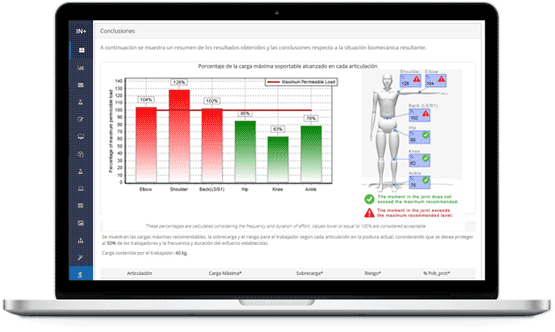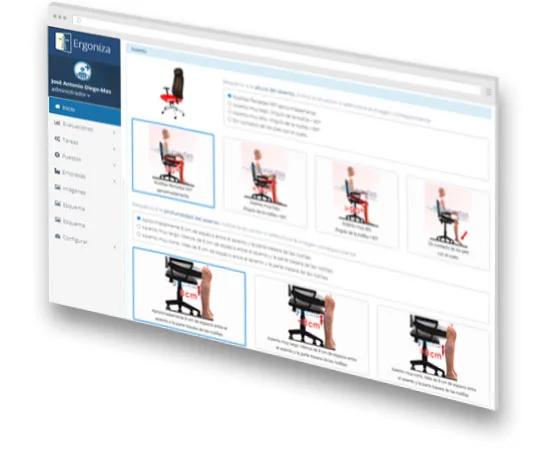

This document presents the basic concepts for assessing the need to conduct an analysis of the ergonomic conditions of manual handling tasks. Its development considers the recommendations of the ISO 11228-1, ISO 11228-2, and ISO/TR 12295 standards. This checklist incorporates new regulations, advancements, and updated knowledge on manual handling of loads as an ergonomic risk factor. MMC-ISO is not an ergonomic risk assessment method in itself but rather a set of principles and recommendations on manual handling of loads, whose non-compliance may increase the risk and necessitate an assessment using an alternative evaluation method.
Based on the recommendations and limits outlined in the MMC-ISO Checklist, it is possible to assess the extent to which a task complies with the recommendations of the cited standards and whether a manual handling risk assessment method is necessary. Among the methods to be used if required are those recommended in the standards, such as the NIOSH Lifting Equation or the Liberty Mutual Tables, applications available in Ergoniza.
The most common causes of health disorders among workers when handling loads include not only excessive load weight (or exerted force) but also inadequate ergonomic conditions (unstable loads, improper grip, slippery surfaces...) and certain characteristics of the worker performing the task (lack of information on ideal lifting conditions, inadequate equipment...). All these aspects to be assessed are included in this guide, which, based on easily collected information, provides guidance to the evaluator on whether a task assessment is necessary.
Remember...
The objective of MMC-ISO is to understand the appropriate conditions for performing manual load handling in a way that minimizes exposure to risk. This helps determine whether a more detailed risk analysis is needed using manual handling risk assessment methods such as the NIOSH Lifting Equation or the Snook and Ciriello Tables.
The fundamental principle of preventive action regarding manual load handling is its elimination through the implementation of technical or organizational measures. In the design of both new and modified work systems, process automation, task mechanization, and the use of auxiliary equipment can contribute to this objective. However, their application must consider system compatibility and the potential generation of new risks.
Risk assessment focuses on hazards that could not be eliminated through technical or organizational measures. In this regard, lifting, placing, and moving objects increase the pressure exerted on intervertebral discs, particularly in the lumbar spine. This increased pressure can lead to injuries of varying severity, especially affecting the intervertebral discs located in the lower back (L5/S1, L4/L5, and L3/L4). In tasks involving pushing or pulling a load, the most critical factors are usually the force required to initiate movement and the sustained effort needed to maintain it during displacement.
Manual load handling is understood as any operation involving the transport or holding of a load by one or more workers. This definition includes Transporting, Holding, Lifting, Placing, Moving, Pushing, and Pulling loads, as well as Lowering loads and the Mobilization of people.
According to the wording of ISO 11228-1, these manual handling operations are defined as follows:
Remember...
The primary preventive action is to eliminate manual handling through technical or organizational measures. If this is not possible, associated risks must be assessed, considering the compatibility of the implemented solutions and the potential emergence of new hazards.
Remember...
Lifting, pushing, or pulling loads requires effort that can cause strain on the spine, particularly in the lumbar region. The most critical moments are the initiation of movement and the sustained effort required during displacement.
Following the guidelines of ISO 11228-1, ISO 11228-2, and ISO/TR 12295, there are five groups of factors that can affect the risk generated by load handling:
Load characteristics.
The characteristics of the load that may increase the risk during handling include: being too heavy or large, being difficult to grasp, having an unstable center of gravity or a risk of shifting, requiring handling away from the trunk or with the trunk twisted or bent sideways, or having a texture or surface that could cause injuries to the worker.Required physical effort.
The following circumstances increase the risk related to physical effort: excessive force requirements, movements involving twisting, bending, or lateral flexion of the trunk, sudden movements of the load, handling in an unstable posture, or the need to adjust the grip during the task.Work environment characteristics.
The characteristics of the work environment can increase the risk associated with load handling when there is insufficient space to perform the task, uneven or slippery floors that could cause trips or slips, inadequate working postures due to improper heights, obstacles or slopes that must be overcome, unstable flooring, inappropriate temperature, humidity, or ventilation conditions, exposure to vibrations, or poor lighting.Task demands.
The level of demand in a task may increase the risk when physical efforts are too frequent or prolonged, when recovery or rest periods are insufficient, when lifting, lowering, or transport distances are long, or when the worker cannot regulate their work pace due to task requirements.Individual risk factors.
Individual risk factors include worker-specific characteristics or task conditions that may affect manual handling risk. These include physical incapacity for the task, improper clothing, footwear, or accessories, lack of knowledge, training, or adaptation to the task, and pre-existing conditions, particularly lower back issues.In the following sections, each of these groups of factors is analyzed in detail.
The mass (or equivalently, weight) of the load is the factor that most directly affects the risk of handling. In general, it is recommended to assess the risk when the weight of the handled loads equals or exceeds 3 kg, taking this as the reference value from the ISO 11228-1 standard. However, it should not be overlooked that handling loads of lower weight can pose a risk when other factors are present, such as the adoption of inadequate postures, repetitiveness, or an inappropriate environment.
It is recommended that the weight of the loads be clearly specified to help workers take precautions and prevent hazardous handling. If this is not possible, workers should at least be informed about the weight of the loads. When necessary, this information should be requested from the manufacturing, supplying, or importing company.
In the case of lifting and lowering loads, it is assumed that under ideal conditions, handling more than 25 kg for men and 20 kg for women always poses a health risk, even without considering additional risk factors (again using ISO 11228-1 as a reference).
The ideal conditions for lifting a load are those in which it is held close to the body, with a straight back, without twisting or bending, and at waist height, with a secure grip, without space restrictions, and under favorable environmental conditions.
The maximum weight limit for handling under ideal conditions is adjusted based on the age and gender of the worker, as outlined in Table 1. Additionally, when the lifting conditions deviate from ideal conditions, the recommended maximum load weight decreases.
| Population Characteristics | Maximum Weight (Kg) | |
|---|---|---|
| Gender | Age (years) | |
| Women | 20-45 | 20 |
| <20 or >45 | 15 | |
| Men | 20-45 | 25 |
| <20 or >45 | 20 | |
Pushing and pulling tasks do not involve supporting the load’s weight but rather applying force to move it. To determine the required force for pushing or pulling a load, a dynamometer must be used.
The force required to initiate the push or pull of an object is greater than the force needed to maintain its movement once it has started. Therefore, a distinction is made in the recommended maximum force, which depends on this factor and the worker’s gender.
The values for the recommended maximum forces are shown in Table 2.
| Gender | Force | |
|---|---|---|
| Initial | Sustained | |
| Women | 240 N | 150 N |
| Men | 360 N | 250 N |
In general, regardless of its weight, a large-volume load increases the risk of lower back injuries because it forces the center of gravity to remain far from the body's center.
Load Width
To ensure safe handling, the width of the load should not exceed the distance between the shoulders. Exceeding this dimension prevents keeping the load close to the body and maintaining a straight and unbent trunk when lifting it from the ground, compromising posture and increasing the risk of injury.
Additionally, an excessively wide load makes gripping difficult and forces awkward arm postures, increasing muscle demand on the back, shoulders, and arms. As a result, the likelihood of fatigue and overload rises, affecting the efficiency and safety of handling.
Load Depth
To minimize the impact on the spine, it is recommended that the grip depth does not exceed 25 cm. An increase in this dimension extends the horizontal grip distance, which in turn generates greater compressive forces on the spine, increasing the risk of overload and injury.
Load Height
To ensure safe transportation, the load should not obstruct the worker’s visibility. Excessive height impairs environmental awareness, increasing the risk of tripping or colliding with objects while moving.
Figure 1 illustrates the reference values for width, height, and depth in load handling.
Ensuring that the load can be grasped comfortably and securely allows for the adoption of a correct working posture. In general, it is preferable for loads to have handles or slots that allow the hand to be easily inserted, enabling a proper grip, even when wearing gloves.
In general, good grips are those performed with optimally designed containers featuring handles or grips, or those on objects without containers that allow for a secure grasp where the hands can comfortably wrap around the object.
A fair grip is one performed on containers with non-optimal handles or grips due to inadequate size, or when holding an object by bending the fingers at a 90º angle.
A poor or bad grip is considered one performed on poorly designed containers, bulky or irregular objects, objects with sharp edges, or when the object is held by pressing it against the sides without bending the fingers.
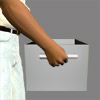 Good
Good
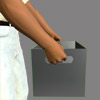 Good
Good
 Fair
Fair
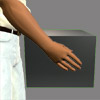 Bad
Bad
Loads should preferably have a stable center of gravity aligned with their geometric center. A shifted or variable center of gravity can increase the risk of injuries in the lower back region. A load is considered to have a shifted center of gravity when its center of mass does not coincide with its geometric center. On the other hand, a center of gravity is considered variable when its position changes during handling.
When the center of gravity is shifted, it increases the compressive forces affecting muscles and joints, particularly in the lumbar area. In such cases, it is recommended to position the heaviest part of the load as close to the body as possible, as shown in Figure 3.
In the case of unstable loads, such as liquids, the continuous shift of the center of gravity requires greater effort for handling, increasing the risk of injury.
Additionally, the load should not contain hazardous elements that could cause injuries, such as sharp edges or cutting components. The surface of the load should not be slippery to prevent sliding and potential falls that may cause impacts.
Finally, objects with very high or very low temperatures can cause burns or loss of sensitivity in the hands, increasing the risk of load slipping and falling.
The risk of developing musculoskeletal disorders (MSDs) associated with manual load handling increases under certain circumstances, even when maximum weight limits are respected. Factors such as the total weight handled over a given period, the distance traveled with the load, and the need to adjust the grip can significantly increase physical demands and, consequently, the risk of injury.
Critical moments in load handling include the start of the lift, placing the load down, and applying the initial force in pushing or pulling tasks. These phases generate the highest pressures on the spine, which can increase further if the load is unstable or if an unexpected movement occurs.
Twisting and bending of the trunk, as well as adopting unstable postures during handling, reduce the back’s ability to withstand effort and may lead to injuries. In particular, trunk rotations increase compressive forces in the lumbar area, making it advisable to design tasks in a way that avoids these movements whenever possible. Figure 4 illustrates the holding of a load with asymmetry in the sagittal plane. This asymmetrical posture is not recommended.
Finally, overexertion can cause MSDs both acutely, with immediate injuries due to excessive effort, and chronically, due to the repeated execution of these actions over time.
In summary, the physical effort required for handling a load can pose a risk under the following circumstances:
When the effort required is excessive.
When the task necessarily involves twisting or bending of the trunk.
When handling is performed abruptly.
When there is instability in the adopted posture.
When lifting or lowering the load requires modifying the way it is gripped.
The availability of sufficient and adequate space is a key factor in ensuring safety during manual load handling. A lack of space may force workers to twist or bend their torso, increasing the risk of injury. In pushing or pulling tasks, it is essential that the workspace allows for proper maneuverability.
Transporting loads over steps, slopes, or uneven surfaces also increases the required effort, placing greater static loads on the muscles and joints of the back. Due to this risk, some regulations, such as those in Spain, prohibit manual handling and transportation of loads on ladders when their weight or dimensions compromise safety.
Environmental conditions can significantly impact the level of risk associated with manual load handling. High temperatures accelerate fatigue, while excessive sweating reduces grip strength. Conversely, extremely low temperatures can cause muscle numbness, especially in the arms and hands, making movements less precise and increasing the likelihood of injuries. Therefore, it is recommended to maintain workplace temperatures within comfort ranges. In Ergoniza, you can use a tool to assess thermal comfort using the Fanger method.
For outdoor activities, weather conditions should be considered an additional risk factor. Adverse conditions such as extreme cold, excessive heat, rain, or strong winds may compromise worker safety. In these cases, it is crucial to implement appropriate protective measures, including suspending certain tasks when safety and health cannot be guaranteed.
Finally, handling loads on vibrating surfaces should be avoided whenever possible, as this factor increases tension in the lower back and other joints, raising the risk of musculoskeletal injuries.
In summary, the characteristics of the work environment can increase the risk of manual load handling under the following circumstances:
When the available space is insufficient to perform the task, especially the availability of vertical space.
If the floor is uneven or slippery, increasing the risk of trips or slips.
When it is not possible to handle the load at an appropriate height and in a correct posture.
When there are level changes on the floor or workspace that require load handling across different heights.
When support surfaces are unstable.
When temperature, humidity, ventilation, or air circulation are inadequate.
When the workspace is not properly illuminated.
When the task involves exposure to vibrations.
Regarding the Frequency and Duration of Handling
Frequent manual load handling or handling over prolonged periods represents a significant biomechanical demand, which can lead to muscle fatigue and increase the risk of lower back injuries due to reduced muscle efficiency. To mitigate these effects, it is essential to implement strategies that include alternating between manual handling tasks and adequate rest periods, as well as diversifying tasks to engage different muscle groups. This approach promotes physical recovery and reduces accumulated fatigue.
ISO 11228-1 establishes that the risk associated with manual material handling (MMH) is considered high when the frequency thresholds exceed those defined in Table 3. This standard provides specific criteria for assessing load exposure and determining the need for preventive measures to minimize ergonomic impact and ensure the safety and health of workers engaged in these tasks.
Regarding Load Position
In activities requiring manual load handling, the combined center of gravity of the load and the worker's body should remain within the footprint area. If the center of gravity of the load is far from the worker's body, the load moment arm on the joints increases. Specifically, the further the load is from the body, the greater the compressive forces on the intervertebral discs, and consequently, the risk of injury is higher.
The acceptable limits for the load’s distance from the body are defined by two parameters: horizontal distance (H) and vertical distance (V). H refers to the distance from the load's grip point to the body, and V is the distance between the ground and the load's grip point. Both parameters are defined for the start of the lift (Hi and Vi) and the end (Hf and Vf), as illustrated in Figure 5.
The vertical displacement (D) of a load refers to the ascending or descending distance the hands travel between the start (Vi) and the end (Vf) of the handling process. The maximum acceptable vertical displacement should range between the worker's knuckles and shoulders, and under no circumstances should a load be lifted above head height.
As mentioned earlier, the load’s horizontal distance is measured at both the start (Hi) and the end of the lift (Hf). To ensure safe handling, neither value should exceed 25 cm.
Regarding Transport Distance
When assessing risk, it is important to consider the transport distance, defined as the distance from where the load is picked up to its placement at the destination. It is recommended that this distance does not exceed 1 meter, and in any case, transport distances greater than 10 meters significantly increase physical demands on the worker, leading to higher metabolic expenditure and increased fatigue risk.
In this context, ISO 11228-1 provides specific guidelines for managing transported loads, including cumulative weight limits over 6 to 8-hour shifts based on the distance traveled. These values, presented in Table 4, define the safety thresholds that should not be exceeded to minimize the impact on worker health.
Regarding Handling Pace
In work environments where manual load handling is dictated by the pace of the production process, there is a high risk of rapid fatigue accumulation, which can compromise worker capacity and increase the likelihood of musculoskeletal disorders. Therefore, whenever possible, the work pace associated with manual load handling should not be determined solely by process demands but should allow for some level of autonomy to facilitate appropriate management of physical exertion by the worker.
Additionally, to prevent voluntary intensification of workload, it is recommended that handling pace not be linked to performance-based incentive systems, as such incentives could lead to greater exposure to biomechanical overload conditions.
| Handling Frequency | Maximum Handling Duration |
|---|---|
| More than 15 lifts/min. | Short-duration handling: 60 min. maximum (followed by at least 60 min. of rest). |
| More than 12 lifts/min. | Medium-duration handling: 120 min. maximum (followed by at least 30 min. of rest). |
| More than 10 lifts/min. | Handling durations exceeding 2 hours. |
| Transport Distance per Handling | Accumulated Weight |
|---|---|
| 1 to 5 meters | 6,000 kg |
| 5 to 10 meters | 3,600 kg |
| 10 to 20 meters | 1,200 kg |
The ability to perform physical activities shows interindividual variations, influenced by factors such as age, body composition, physical condition, and overall health status. These elements should be considered as risk factors when conducting risk assessments in manual load handling, in order to adapt working conditions to the worker’s capabilities and minimize the likelihood of injuries.
Additionally, clothing and other personal accessories can interfere with the safe execution of manual load handling. Accessories such as large pockets, belts, or loose objects can pose a risk of entrapment or snagging, increasing the possibility of accidents. Regarding the use of lumbar belts, their use in manual handling tasks is not recommended, except in specific cases under medical prescription, as they can create a false sense of security and encourage improper postures.
Footwear is another crucial aspect of risk prevention. It should provide stable foot support, have a non-slip sole, and offer adequate protection against falling objects. Similarly, the use of personal protective equipment (PPE) should ensure effective protection without creating additional risks or interference with the task. For example, safety glasses should not obstruct visibility, and gloves should allow an adequate level of manual dexterity to ensure a secure grip on the load.
Furthermore, training in manual handling should have a theoretical-practical approach adapted to the individual characteristics of workers and the nature of the activity being performed. Special attention should be given to workers with a medical history of lower back conditions, as they have a higher risk of recurrence and are more susceptible to new injuries.
In the risk assessment of manual load handling, there are specific situations that require detailed analysis due to their biomechanical and organizational particularities. Among them, the following stand out:
Handling Loads in a Seated Position
Handling loads while sitting presents a significant biomechanical limitation, as it is not possible to use leg strength during lifting or employ the body as a counterweight. Consequently, the effort falls mainly on the muscles of the arms and trunk, which have a lower capacity for force generation. Additionally, this posture alters lumbar curvature, increasing the risk of spinal overload and potentially leading to musculoskeletal disorders.
Team Handling
When handling is performed jointly by two or more people, the lifting capacity of the team is not equal to the sum of individual capacities. Specifically, in the case of two workers, the combined capacity is approximately two-thirds of the individual sum, while if the team consists of three people, the effective lifting capacity is reduced to half of that sum. In addition to this reduction in efficiency, team handling presents additional challenges, such as the need for movement synchronization, unequal load distribution, and difficulty in visualizing the maneuver, all of which can increase the risk of incidents.
Handling of People and Other Living Beings
Handling living beings presents a high level of risk due to the possibility of unexpected and sudden movements of the load, which makes it difficult to accurately quantify the required effort and increases the probability of accidents. This type of handling is common in environments such as hospitals, childcare centers, farms, and veterinary clinics.
To minimize the risks associated with handling animals, it is recommended to prioritize the autonomous movement of the living being whenever possible, thereby reducing the need for manual handling. When physical intervention is necessary, appropriate mechanical aids should be used, and in the case of group handling, the action should be planned in a coordinated manner, considering ergonomic and postural hygiene principles. Additionally, if the situation allows, it is advisable to safely immobilize the animal and apply handling techniques that help calm it, thereby reducing the likelihood of unexpected movements that could compromise the worker's safety.
As previously mentioned, the MMC-ISO Checklist is not an ergonomic risk assessment method but rather a checklist based on the guidelines of ISO 11228-1, ISO 11228-2, and ISO/TR 12295. It evaluates a set of principles and recommendations regarding manual load handling, where non-compliance may increase the risk and necessitate an assessment using an alternative evaluation method. As a result of its application, the extent to which the evaluated task complies with the standards' recommendations will be determined, allowing the evaluator to decide whether further risk assessment is required using a specific manual handling evaluation method.
Thus, MMC-ISO Checklist, implemented in an online software tool, enables a systematic consideration of handling characteristics but does not provide recommendations on the necessity of an advanced analysis using other more specific methods. The decision remains the responsibility of the evaluator. If a risk assessment is deemed necessary, it should be conducted using methods described in the respective standards or by applying the NIOSH Lifting Equation or the Liberty Mutual Tables, both of which are available in Ergoniza.
MMC-ISO presents the evaluator with 41 questions (items) related to the manual handling of loads under assessment. If more than one type of handling is performed in a task, the checklist should be applied as many times as necessary to cover all types of handling involved. The items are classified into 6 Groups, each addressing different aspects of manual handling. The Groups and Items are presented in Tables 5 to 10.
You may be interested...
To facilitate data collection, Ergonautas provides this Field Sheet for the MMC-ISO Checklist for the checklist application. Click on the image to download it.
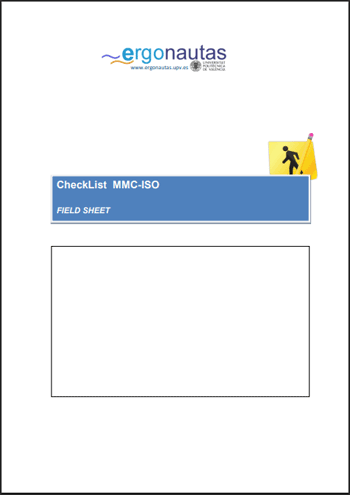
Each item in the checklist asks whether a specific condition occurs during handling. There are only two possible answers: Yes or No. You should answer Yes when the condition described in the question is present in the evaluated handling task and No otherwise.
The procedure for applying the MMC-ISO Checklist can be summarized in the following steps:
Observe the tasks performed by the worker.
Identify work cycles (if applicable) and observe the worker over multiple cycles or for a sufficient amount of time if no cycles exist.Select the manual handling tasks to be evaluated.
If multiple types of handling exist, the MMC-ISO Checklist should be applied multiple times to assess each one.Gather the necessary data to complete the MMC-ISO Checklist
The load being handled must be observed, and its weight, dimensions, and characteristics must be recorded.Answer all items in the MMC-ISO Checklist.
Answering the items by group facilitates the process, as each group focuses on a specific aspect of manual handling.Count the number of items where the answer is a in each item group.
The score reflects the number of manual handling principles and recommendations that are not met in each item group.Sum the scores from all item groups.
The total score represents the number of manual handling principles and recommendations that were not met in the analyzed task.Assess whether it is necessary to analyze the risk of manual handling and implement improvements.
Review the overall score and individual group scores to decide whether an advanced risk assessment is necessary. In any case, if the final score is not 0, improvements should be introduced to eliminate the identified risks.The following tables present the items organized into groups.
In Group A - Weight of the Handled Load or Exerted Force, Item A2 should be answered by selecting the appropriate question depending on the type of load handling.
| GROUP A - Weight of the Handled Load or Exerted Force | ||||||||||||||
|---|---|---|---|---|---|---|---|---|---|---|---|---|---|---|
| No. | Item | |||||||||||||
| A1 | Is it possible to eliminate the need for manual load handling by implementing technical measures (such as the introduction of machinery) or organizational measures? | |||||||||||||
| Responses | a - Yes | b - No | ||||||||||||
| A2 | Complete if the type of handling involves Transport, Holding, Lifting, Lowering, Placement, or Movement. | Do any of the following conditions apply?
- More than 25 kg is handled. - The worker is a woman handling more than 20 kg. - The worker is a man under 20 or over 45 years old handling more than 20 kg. - The worker is a woman under 20 or over 45 years old handling more than 15 kg. |
||||||||||||
| Responses | a - Yes | b - No | ||||||||||||
| Complete if the type of handling involves Pushing or Pulling. | Do any of the following conditions apply?
- The initial or sustained force exceeds 360 Newtons. - The worker is a woman and the initial force exceeds 240 Newtons. - The worker is a woman and the sustained force exceeds 150 Newtons. - The worker is a woman and the sustained force exceeds 250 Newtons. |
|||||||||||||
| Responses | a - Yes | b - No | ||||||||||||
| GROUP B - Load Characteristics | ||||
|---|---|---|---|---|
| Subgroup | No. | Item | ||
| Load Shape and Dimensions | B1 | Is the load width greater than the worker's shoulder width? | ||
| Responses | a - Yes | b - No | ||
| B2 | Does the depth of the load require the grip point to be more than 25 cm from the body? | |||
| Responses | a - Yes | b - No | ||
| B3 | Does the height of the load obstruct the worker's visibility? | |||
| Responses | a - Yes | b - No | ||
| Load Grip Quality | B4 | Is the grip quality of the load poor or inadequate? | ||
| Responses | a - Yes | b - No | ||
| Load Stability and Surface Properties | B5 | Is the center of gravity of the load unstable? | ||
| Responses | a - Yes | b - No | ||
| B6 | Is the center of gravity of the load misaligned with its geometric center? | |||
| Responses | a - Yes | b - No | ||
| B7 | Is the heaviest part of the load the farthest from the body? | |||
| Responses | a - Yes | b - No | ||
| B8 | Does the load have sharp edges or cutting elements? | |||
| Responses | a - Yes | b - No | ||
| B9 | Is the load slippery? | |||
| Responses | a - Yes | b - No | ||
| B10 | Is the load temperature extremely high or low? | |||
| Responses | a - Yes | b - No | ||
| GROUP C - Required Physical Effort | |||
|---|---|---|---|
| No. | Item | ||
| C1 | Is the load handled while in a seated position? | ||
| Responses | a - Yes | b - No | |
| C2 | Is the handling performed by more than one person? | ||
| Responses | a - Yes | b - No | |
| C3 | Can the effort required for the handling be considered high? | ||
| Responses | a - Yes | b - No | |
| C4 | Is it necessary to change grip during handling? | ||
| Responses | a - Yes | b - No | |
| C5 | Is it necessary to twist or bend the torso laterally? | ||
| Responses | a - Yes | b - No | |
| C6 | Are unexpected or sudden movements occurring? | ||
| Responses | a - Yes | b - No | |
| C7 | Are unstable postures adopted? | ||
| Responses | a - Yes | b - No | |
| GROUP D - Environmental Characteristics | |||
|---|---|---|---|
| No. | Item | ||
| D1 | Is the space insufficient, requiring handling with turns, inclinations, or maneuvering difficulties? | ||
| Responses | a - Yes | b - No | |
| D2 | Are slopes, steps, or uneven surfaces present? | ||
| Responses | a - Yes | b - No | |
| D3 | Is the handling performed on vibrating or mobile surfaces? | ||
| Responses | a - Yes | b - No | |
| D4 | Is the temperature too high during handling? | ||
| Responses | a - Yes | b - No | |
| D5 | Is the temperature too low during handling? | ||
| Responses | a - Yes | b - No | |
| D6 | Is the handling performed outdoors with potentially adverse weather conditions (rain, wind, etc.)? | ||
| Responses | a - Yes | b - No | |
| D7 | Is the lighting inadequate, or is the noise level excessive? | ||
| Responses | a - Yes | b - No | |
| GROUP E - Task Demands | |||
|---|---|---|---|
| No. | Item | ||
| E1 | Do any of the following circumstances occur? The handling...
- Is performed more than 15 times per minute. - Lasts more than 2 hours and is performed more than 10 times per minute. - Lasts between 1 and 2 hours, with a rest period of less than 30 minutes, and is performed more than 10 times per minute. - Lasts between 1 and 2 hours, followed by more than 30 minutes of rest, and is performed more than 12 times per minute. - Lasts less than 1 hour, followed by a rest period of less than 1 hour but more than 30 minutes, and is performed more than 12 times per minute. - Lasts less than 1 hour, followed by a rest period of less than 30 minutes, and is performed more than 10 times per minute. |
||
| Responses | a - Yes | b - No | |
| E2 | Are the hands positioned above 175 cm or below foot level at the start and end of the handling? | ||
| Responses | a - Yes | b - No | |
| E3 | Is the vertical distance between the origin and destination of the handled object greater than 175 cm? | ||
| Responses | a - Yes | b - No | |
| E4 | Is the horizontal distance between the body and the load greater than a fully extended arm (>63 cm)? | ||
| Responses | a - Yes | b - No | |
| E5 | Is the vertical displacement of the load performed outside the distance between the worker’s knuckles and shoulders? | ||
| Responses | a - Yes | b - No | |
| E6 | Is the horizontal distance of the load during handling greater than 25 cm? | ||
| Responses | a - Yes | b - No | |
| E7 | Do any of the following circumstances occur? The transport distance...
- Is greater than 20 meters. - Ranges between 10 and 20 meters, and the accumulated transported weight is greater than 1200 kg. - Ranges between 5 and 10 meters, and the accumulated transported weight is greater than 3600 kg. - Ranges between 1 and 5 meters, and the accumulated transported weight is greater than 6000 kg. |
||
| Responses | a - Yes | b - No | |
| E8 | Is the work pace associated with manual load handling determined by the process requirements? | ||
| Responses | a - Yes | b - No | |
| E9 | Is the work pace linked to performance-based salary incentive systems? | ||
| Responses | a - Yes | b - No | |
| GROUP F - Individual Factors | |||
|---|---|---|---|
| No. | Item | ||
| F1 | Is the worker's physique and physical condition below average? | ||
| Responses | a - Yes | b - No | |
| F2 | Is the worker's general health condition poor? | ||
| Responses | a - Yes | b - No | |
| F3 | Does the worker wear clothing or personal accessories that may interfere with safe handling? | ||
| Responses | a - Yes | b - No | |
| F4 | Is the footwear used inadequate and prone to slipping? | ||
| Responses | a - Yes | b - No | |
| F5 | Does the worker lack adequate training on the task and manual handling? | ||
| Responses | a - Yes | b - No | |
| F6 | Does the worker have a history of lumbar disorders? | ||
| Responses | a - Yes | b - No | |
UNE-EN 1005-2: 2004+A1:2009 Safety of machinery. Physical behavior of the human body. Part 2: Handling of machinery and its components.
ISO 11228-1:2021 Ergonomics — Manual handling — Part 1: Lifting, lowering, and carrying.
ISO 11228-2: 2007 Ergonomics – Manual handling – Part 2: Pushing and pulling.
ISO/TR 12295: 2014: 2007 Application document for International Standards on manual handling.
Diego-Mas, J.A., Poveda-Bautista, R. & Garzon-Leal, D.C., 2015. Influences on the use of observational methods by practitioners when identifying risk factors in physical work. Ergonomics, 58(10), pp. 1660-70.
Waters, T.R. & Putz-Anderson, V.,1994. NIOSH. Applications Manual for the revised NIOSH lifting equation. Publication No. 94-110. US Department of Health and Human Services, National Institute for Occupational Safety and Health, Cincinnati, OH.
Waters, T.R., Putz-Anderson, V., Garg, A., & Fine, L.J., 1993. Revised NIOSH equation for the design and evaluation of manual lifting tasks, Ergonomics 36, (7) 749-776.
Technical Guide for the Evaluation and Prevention of Risks Derived from Manual Handling of Loads. National Institute for Occupational Safety and Health (INSST), O.A., M.P. 2024
How to cite this document:
Diego-Mas, Jose Antonio. Evaluation of Manual Handling of Loads using MmcINSST. Ergonautas, Polytechnic University of Valencia, 2025. [accessed 20-02-2025]. Available online: https://www.ergonautas.upv.es/metodos/MmcINSST/MmcINSST-ayuda.php
A cloud based software that integrates more than 20 tools for managing the ergonomics of the workstations in your company.
Evaluate all ergonomic risk factors of the workstations in your company: inadequate postures, repetitive movements, load handling, thermal environment...

Use Artificial Intelligence for the automated detection of postures in photographs or videos.
Generate fully customizable reports in Microsoft Word or Adobe Pdf format.
In a multiuser environment so that your company can have access to your data everywhere.
You only need a free account on Ergoniza
ERGONIZA allows you to use Artificial Intelligence for postural load assessment. Automatically capture workers’ postures from a photograph or a video and obtain an automated evaluation of the risk associated with inadequate or forced postures.
AI in actionERGONIZA helps you manage the ergonomics of the workstations of your companies. Evaluate all the risk factors present in the workstations, manage the evaluations, and obtain editable and customizable reports.
You only need to register as a user of ERGONIZA to start testing.
Sign UpUnlock the full potential of Ergoniza. By becoming a Pro User you'll have access to all of Ergoniza and be able to use all of the online software without restrictions or time limits. You'll be able to use the results of evaluation methods and tools in your professional activity. You'll be able to print the results reports in pdf or Word and save your studies in files to open them later.
To register as a Pro user, you must first login to Ergoniza.
(*) In European Union countries, the price will be increased with the corresponding VAT.
(**) The price in american dollars has been calculated at the current exchange rate and may vary.
is a web by . Ergonautas is the specialized website in occupational ergonomics and ergonomic assessment of workstations at the . Ergonautas aims to be a useful support tool for the Occupational Risk Prevention and Ergonomics professional and people in training, providing rigorous technical information on occupational ergonomics, online tools for its application, research, training, and participation forums.
Ergonautas is formed by a large human team. In addition to technicians and programmers, the Ergonautas team is made up of researchers and professors from the Polytechnic University of Valencia. The team, led by José Antonio Diego Más, is at the forefront of research and teaching in ergonomics, teaching in official degrees and master's degrees, and developing research projects in the field of ergonomics and new technologies oriented towards humans.
If you need to know more, get in touch with Ergonautas
Or follow us on Linkedin
- - -
© 2006 - Universidad Politécnica de Valencia
